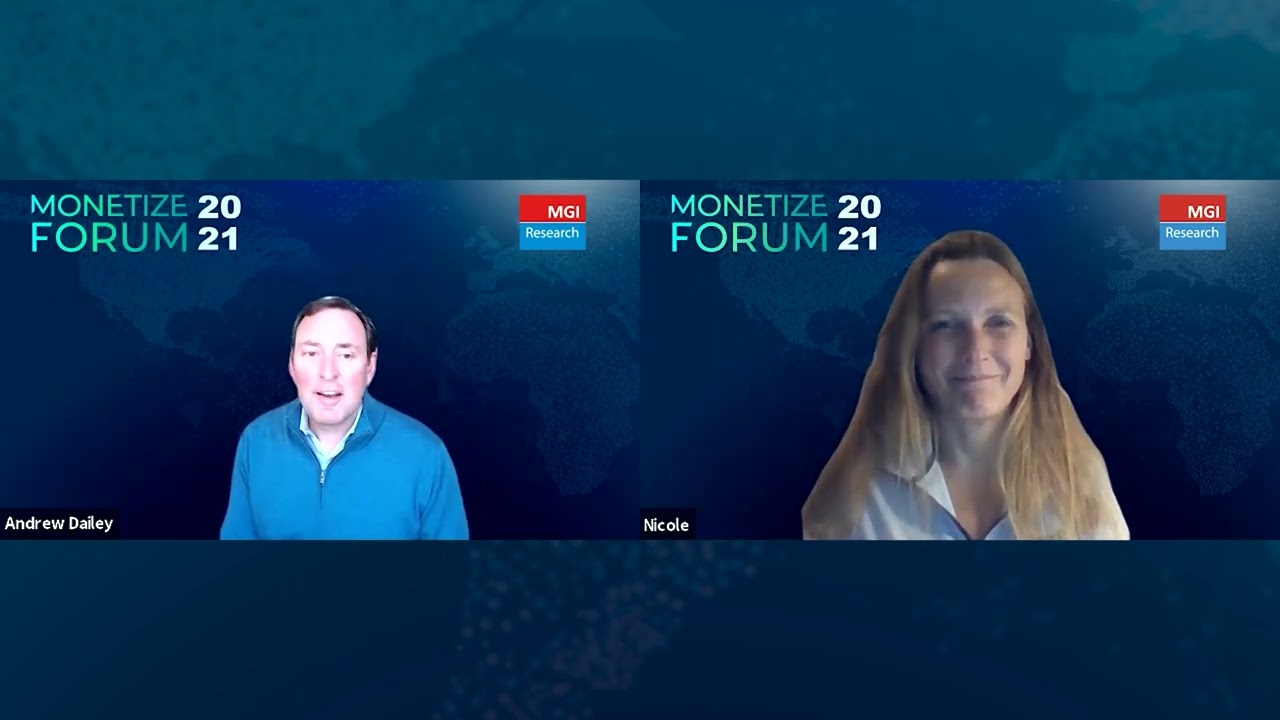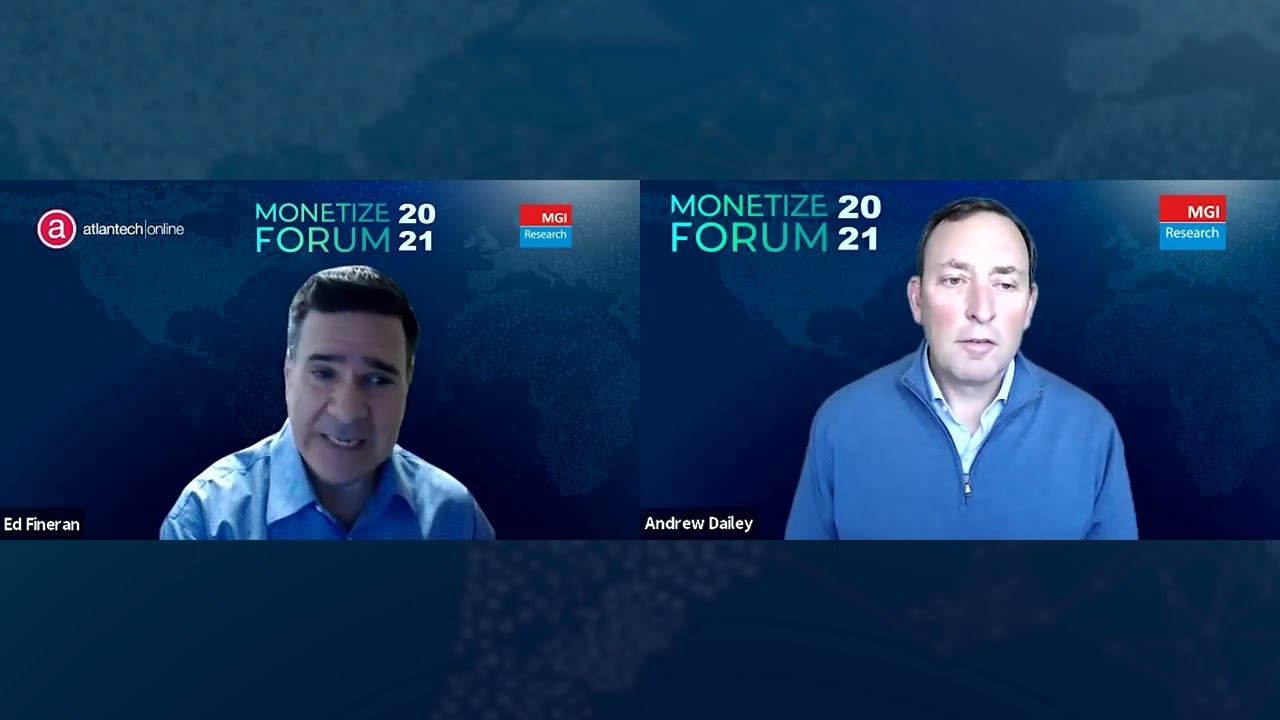The unified communications industry can be an unattractive target for monetization suppliers given its complexity of channels and hybrid offerings. The industry’s changing nature is also often seen as a challenge, but it’s the very reason why usage billing platform Rev.io sees this space as so exciting today. As telecom companies are expanding their services on one side and managed service providers start incorporating telecom on the other, there is increasing demand for experienced and invested usage billing solutions providers to enable scalable monetization. To learn more about the company’s history and plans for the future, we invited Patrick Elliott, Rev.io’s Vice President of Marketing to speak with MGI Research analyst Andrew Dailey at the 2021 Monetize Forum.
Key Issues
What are the challenges and opportunities of unified communications related to monetization?
How will the requirements for usage models change in the coming years?
What are best practices for billing implementations?
Guest Profile
Patrick is the VP of Marketing at Rev.io and leads the team responsible for content creation, creative design, in-market execution, advertising, media strategy, and demand creation for Rev.io’s platform. Patrick has nearly 15 years of experience in B2B marketing, product and brand management, and business development in a variety of complex industries, including enterprise technology.
Andrew Dailey
Welcome, everyone. This is Andrew Dailey of MGI Research, and our next session is “Unified Communications and Managed Services Billing for Growth.” I’m joined by Patrick Elliott who is Vice President of Marketing at Rev.io, and we’re extremely interested in hearing his views on the market. Welcome, Patrick.
Patrick Elliott
Hi, Andrew. Thanks for your welcome and for the opportunity today.
Andrew Dailey
Let’s jump right into it. For those of us who maybe don’t know Rev.io, give us a sense of your business scope and scale and where you guys are today.
Patrick Elliott
Let me talk about our product for a couple minutes, and then I can step into a larger sense of the company itself and where we are today. Rev.io is a cloud-based, SaaS-based billing, customer management, and payments software platform. We serve clients in a variety of areas that we collectively refer to as the advanced communications industry, and that really includes the wide umbrella of telecom—everything from VoIP and CLEC to UCaaS and CCaaS, plus everything in between. That includes managed service providers, IoT solutions providers, things like MVNOs, et cetera. Fundamentally, we see ourselves as a billing-as-a-service provider to companies in these areas, particularly the ones with complex recurring revenue or consumption-based business models. Our software deploys sophisticated billing at its center with the key advantage of our high-velocity usage rating which really separates our system from a lot of the other broad-based subscription billing systems in the market today.
We combine this core capability billing and usage rating with a robust reporting and business intelligence engine which includes over 100 built-in reports as well as very strong custom report-building capabilities. We’ve streamlined integrations with tax databases such as Avalara’s AvaTax and Wolters Kluwer’s SureTax to ensure that the very complicated telecom taxation regimes are calculated correctly. We’ve automated bill creation and distribution to end customers. We’ve automated collections to speed cash and reduce AR. Finally, we have integration with payment processing native to our system that unifies everything together in a full quote-to-cash environment.
Looking at our business, we have over 18 years of experience in the market, having been founded in 2002 in Pensacola, Florida. Our first client there was a small, regional telecom provider in North Florida, and today we have over 150 direct clients plus hundreds of indirect clients that we’re able to serve through our bill-on-behalf relationships with resellers. We are a seven-time Inc. 5000 winner and a three-time Great Place to Work winner; we’ve also won a myriad of other awards from various communications and SaaS industry groups.
I’ll say one other thing about our company. 2020 was (for reasons that we don’t need to get into) obviously an extremely challenging period economically and socially, but through that period, we actually grew our team headcount by 20%. We maintained a very solid recurring revenue growth rate while also onboarding over two dozen new clients, mostly while remote. And in September, we announced a significant growth equity investment from Primus Capital, a leading private equity investor in technology and software companies. Their investment is really going to allow us to accelerate a lot of initiatives we’ve set out in technology, product development, and marketplace expansion.
Andrew Dailey
Terrific. We’ll come back to the Primus Capital topic in a bit. First, though, from a billing and monetization perspective, the unified communications industry (or advanced communications industry, as you described it) is full of complexity. You have multi-tiered channel relationships; often you’re selling a mix of hardware, software, and professional services; and it’s an industry that’s undergone an enormous amount of change in the last three years alone. There are quite a few monetization suppliers who really view this as a tough market and don’t want to compete in it or are trying to get out and move to easier marketplaces. However, Rev.io is really leaning into it right now. Why is that? What makes this a uniquely attractive market for you guys?
Patrick Elliott
You’re right. This is indeed a very complex industry, but we are 100% dedicated to this space. We’re intently focused on our clients in the market for a few reasons. First and fundamentally, I talked about our company history: we are one of the most experienced billing software providers serving advanced communications with 18, going on 19, years of experience. With that deep telecom experience, we’ve built up a lot of expertise among both our leadership and our technical staff. We understand what our clients want and need, and we’ve been with a lot of them for many years through various market cycles and waves of change in technology. For a lot of companies that haven’t been so deeply invested in this space in years past and are now trying to get into it from scratch, we understand there’s a very challenging barrier to climb, but our experience has built expertise that we think puts us in a good position to continue to serve the market.
The second reason that we remain so invested is because we’ve set up such a strong usage rating engine within our system. A key factor driving complexity in telecommunications is usage calculations and how those flow through to billing and ultimately monetization. It’s indeed very hard to build something like that from the ground up, which is why we think many subscription billing companies that are more broadly focused aren’t jumping into this part of the marketplace. Incidentally, though, we also think it’s why a lot of companies that offer telecom services need to be looking at a platform like ours in order to accurately blend the usage rating, taxation, and other factors that I mentioned before.
A third reason is that we honestly see a tremendous amount of opportunity right now for really well-run, scaling businesses to thrive in the industry. There’s a particularly unique opportunity right now because of the convergence of traditional telecom with managed services. In some of the previous areas we’ve operated in, these were pretty distinct kinds of companies, and you didn’t necessarily jump from one side of the fence to the other. Now, however, you see telecom providers expanding their service offerings and MSPs getting into telecom so that they can drive more of that all-important recurring revenue and create more customer retention. At the same time, we do see that a lot of MSPs that are expanding into more of the telecom services see the complexity pretty early on. Again, that’s where a system like Rev.io can help them address things like complex taxation, usage rating calculations, et cetera. The bottom line is that we’re very excited about this industry. We think it’s got a great future ahead of it, and we’re proud to continue to serve it.
Andrew Dailey
You mentioned usage rating. One of the core themes of the Monetize Forum is different perspectives on usage models. As you look into 2021 and even 2022, how do you see the requirements landscape changing or evolving in your market?
Patrick Elliott
A couple of things come to mind on that question. Firstly, like I just said a moment ago, I think the ongoing consolidation of telecom and managed services is going to continue to affect requirements in terms of what clients are looking for. We think about things like, “How can we bring a single source of truth to these clients?” We have to create well-integrated systems across different software packages that are widely used, so that clients can best manage the full quote-to-cash process to avoid revenue leakage, increase efficiency, and make themselves indispensable to their end customers in many ways as these customers ask for more services from a smaller number of vendors. So, I think consolidation and that single source of truth are number one.
Secondly, you can’t get through one session like this nowadays without talking about the pandemic and economic effects of it. Our belief is that there’s a lot of sustainability in this remote work trend that I think will persist in some ways, even as more workers do come back to the office. We’ve seen a lot of our providers in telecom and managed services really benefit to some degree this year because of the accelerated demand for remote connectivity services to keep their end customers going. I’m not going to try to handicap what the end game of this is going to be; I don’t think I’m the right person to ask or that this is necessarily the forum for that. That said, we believe it’s going to be the best of both worlds, that a hybrid model is what companies are going to go for. When we talk with peer firms, our clients, and other people that we think have the right operating model in mind, they want to go back to the office to some degree to build cohesion and culture with their teams. At the same time, though, they’ve seen a lot of the positive effects from the upside of remote work. So, if you think about it as a hybrid model, where you can leverage both team unity and some of the cost savings and efficiencies, that’s going to continue to drive a pretty healthy demand for remote connectivity, which we think ultimately benefits the industry significantly.
Thirdly, this is one that’s maybe not quite right in the crosshairs of what people are thinking about day to day, but we think that there’s going to be an increased demand for real, solid data analytics, and ultimately, better business intelligence from executive leaders. Basically, firms that are able to best distill and analyze data that can help businesses make better decisions (essentially, it’s data monetization)—we think that’s something that, in the not-too-distant future, is going to be a pretty important factor from a changing requirements standpoint. Versus the other two factors: the convergence of telecom and managed services and then the remote workplace that people are thinking about a lot, this third thing is something that’s maybe a little bit further down the line, but it’s definitely something that’s on our minds as well.
Andrew Dailey
There’s certainly a natural affinity between billing and payments, and yet, very few billing companies have successfully entered the payments space. And conversely, very few of the payments companies have done well in the billing space. You guys have put the two together successfully, so what do you see as the customer benefit of embedding payments in your solution?
Patrick Elliott
Yes, I appreciate you pointing that out, Andrew. There has definitely been mixed success despite the natural affinity. Since we launched Rev.io Payments in 2018—and, as far as we can tell, we’re the only provider in our specific part of the space serving advanced communications that has this native merchant processing integrated within our system—we really think there are three key benefits to this from a client perspective.
Firstly, having the two together creates a single source of truth for your financial and back-office systems. You have a single place to view customer information, billing cycle data, and payment center information for specific customers, as well as the ability to confirm all the data. Secondly, it creates a lot of transparency for clients into the cost of their payment processing. Many third-party systems are a little bit more opaque with more hidden fees, and we don’t really have that within Rev.io Payments. Thirdly, it supports speed in processing payments. Obviously, that’s a critical part of the overall quote-to-cash continuum, but that speed is probably the third benefit we see here. We do admit it’s operationally complex, but marrying the two together just made sense, and we think it gives us the ability to create a lot more value for our clients overall.
Andrew Dailey
People certainly want more speed and transparency, and those build trust. Let’s shift gears a little bit. Every billing vendor worth their salt claims to have an implementation methodology. Rev.io is no exception; it’s a critical piece. When we look at the success of projects, that’s often independent from a particular product or its capabilities. Rather, it really comes down to how successful an organization is at bringing that product in, successfully migrating from a legacy system, and standing up the new one. What do you guys do differently from a methodology, process, and tooling point of view that you think differentiates your implementation capability from others?
Patrick Elliott
It’s a great question, Andrew. A few things definitely come to mind concerning process, team, and training. Firstly, we do have a deliberate process for onboarding our new clients onto Rev.io with really set timelines and what we call our Rev.io Go program. This starts with a kickoff and moves through phases for requirements gathering, setting up product catalogs in the system, configurations, CDR development, tax database setups, usage testing and comparative bill runs, and, ultimately, continuous support to the first bill out. All this is defined in a project charter that is established at the beginning of every onboarding project with a new client.
Secondly, we have a team built and organized to support these projects. These projects begin with a dedicated project manager who really plays quarterback from a Rev.io perspective and manages the process with the client through hitting timelines against the project charter. We also have dedicated data migration engineers that we assign to projects. They’re trained in SQL, and these are the men and women that scope out and execute on complex data mapping, reconciliation, and, ultimately, the migration into our system. We also support onboarding with our solutions analysts who are experts on our product and help optimize configurations for client needs. Additionally, we dedicate development resources within onboarding. We have a team that works solely on onboarding projects and helps foster through the needs to meet client technical requirements within onboarding. Then, as I mentioned, we have testing. At several steps within our project plan, we will test and check for issues like configuration flaws and system connection problems. We will also run bill comparisons and look for any inconsistencies between the legacy system and Rev.io so that, when we’re actually running the bills, we’re not creating inaccuracies and driving issues for clients and the end customer.
We also have hands-on training through what we call our Rev.io Academy program, where new client users run through an intensive, roughly day-and-a-half training to get up to speed on our key system functionality. That combines with an extensive knowledge base which can be accessed right from the home screen of our system. We have videos that reinforce the usage of and best practices for our system. Our overall aim from the Academy to the continuous training is to really get users equipped to use our system optimally, specifically as onboarding transitions clients to support by our client success department. The bottom line is this: We’ve done this a lot, for a long time. We understand what works. We’ve organized our onboarding to comprehensively model and execute projects, and we really remain committed to best practices here to make sure that our clients are set up for maximum success when they go live.
Andrew Dailey
We’re almost out of time here, but I want to very quickly squeeze in two last questions. Firstly, as you mentioned, Rev.io raised a large round of growth capital from Primus in the midst of the pandemic last year. How does that change your growth trajectory? Ostensibly, they asked you guys how you’re going to put this money to work, and you had a good answer for that. In sixty seconds or less—where’s that money going to go?
Patrick Elliott
When people ask, “How did you end up raising money in the midst of a pandemic?” it’s important to point out the really long-term view that Primus takes in their investments as well as the really deep due diligence that was part of their evaluation of us. Basically, I think the equity stake from Primus Capital within Rev.io is going to help us achieve long-term goals in three different ways.
First, it’s going to help us really build our technology capabilities at scale, leveraging both investment and expertise to make sure our platform stays on the cutting edge with best performance as well as by making sure we have the best possible technology team in place, both at leadership levels and in the functional areas within engineering and product development.
Secondly, we’re going to leverage the strategic expertise from the Primus team. That expertise has been built through dozens of successful SaaS investments over a 35-year history. We talk a lot about the communications industry that we serve, but we’re fundamentally a SaaS company, so being able to benchmark ourselves against a lot of these great portfolio companies and the broader industry of SaaS providers will allow us to look at ways to run best practices, measure ourselves, and see what the best ways for us to hit our growth targets are. Most importantly, though, we’re looking to see how to best serve our clients while achieving scalability in our operating models.
Thirdly, this will also give us the opportunity to really expand our addressable market. We have long-term plans to really grow within our core set of what we offer from a billing software perspective, but we really want to expand offerings and capabilities, both to our current clients and current prospect base and also to a wider market opportunity that is out there, to really carve out a unique position in our peer group of billing software companies. So, we’re very excited to get the chance to partner with Primus Capital. They’ve been tremendous since we started working with them directly a couple of months back, and we’re really looking forward to what they can help us with in the years to come.
Andrew Dailey
Terrific. So, one last question: in 60 seconds or less, what’s one thing every CEO or CFO should know about Rev.io but doesn’t yet?
Patrick Elliott
Yes, CEOs and CFOs will ask us, “Hey, what’s the right time for a communications company like ours to bring on Rev.io?” Our response is that if you can say your billing and back office have become an inhibitor to efficient revenue growth, rather than an enabler of efficient revenue growth, it might be time to bring on Rev.io. I’m very deliberate with those words because the mission of our company is to help clients grow revenue efficiently—that means, “How do I meet my growth goals while also managing the increased cost and overhead that go with that fast growth?” Over 18 years in business, we’ve helped many executives and their companies achieve goals while overcoming a lot of the core business issues.
While there have been a lot of those technology waves and market cycles, the core issues stay the same. Clients ask, “How do I enter new markets and launch new products efficiently?” We’ve helped numerous clients reach recurring annual revenue growth rates of 30% or higher in the years since they brought on Rev.io. Clients ask, “How do we operationalize M&A that we brought in?” We have clients like CallTower, which made two major acquisitions in two years, and within a short period of time, they were able to seamlessly integrate those billing profiles into the Rev.io instance, allowing them to keep plugging along with the growth that they had seen with us before. Clients want to know how to get more efficient in their staff time, putting staff on strategic projects rather than routinized manual tasks. We’ve done that with a lot of clients. Spectrotel (one of our largest clients) comes to mind. They saved a million dollars in OpEx the first year they were on Rev.io, and they’ve been able to maintain a very slim staff using and managing the system well, despite the fact that their revenue has grown times three over seven years with us. Then, there are things like creating digital transformation. As part of the Monetize Forum, you’re going to hear from Atlantech, one of our best clients. They have an integration with Rev.io to a Power BI dashboard and have been able to get much more effective in terms of using data to run their business. After just six months with this dashboard in place, they were able to reduce their churn by a full half percentage point, which is a lot in a short period of time.
All these different ways to use our system really help overcome those issues that go back to that core question: “Is billing and my back office an inhibitor to my growth?” A system like Rev.io can make them an enabler again, and that’s probably the one thing I would want our audience to know about if they’re thinking through that question for themselves.
Andrew Dailey
Terrific, Patrick. Thanks very much for joining us. I know there’s more information available at the Rev.io booth, and you’re going to be around for the networking, so I would encourage everyone to reach out. Thanks again, and thanks, everyone, for joining us. This concludes our session.
Patrick Elliott
Thanks, Andrew. Thanks, everyone.




